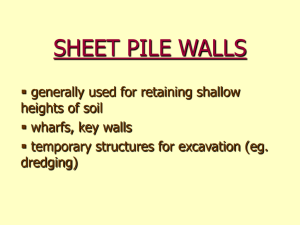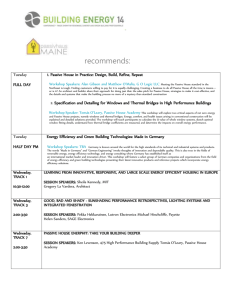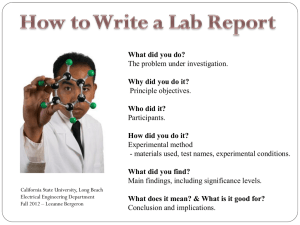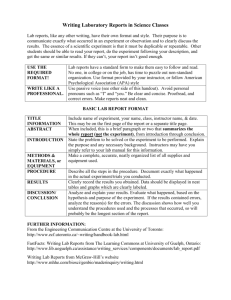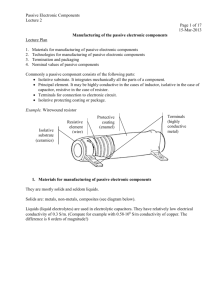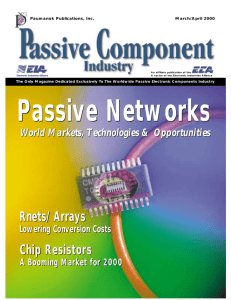A Syllabus of course 36114111 PASSIVE ELECTRONIC
advertisement
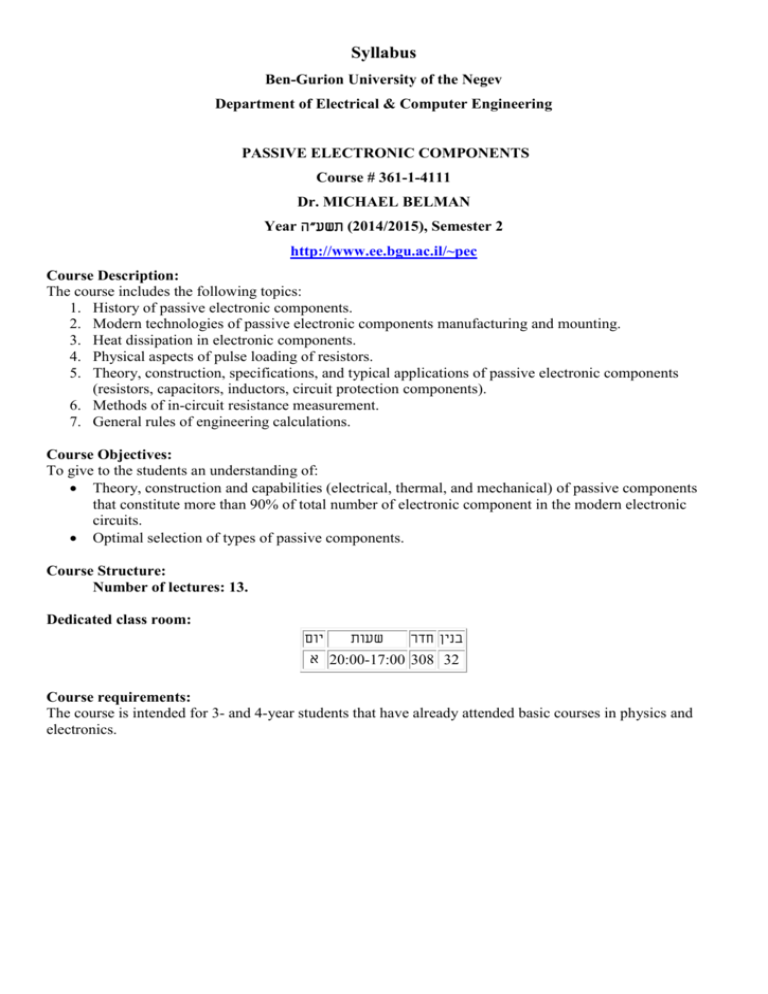
Syllabus Ben-Gurion University of the Negev Department of Electrical & Computer Engineering PASSIVE ELECTRONIC COMPONENTS Course # 361-1-4111 Dr. MICHAEL BELMAN Year ( תשע"ה2014/2015), Semester 2 http://www.ee.bgu.ac.il/~pec Course Description: The course includes the following topics: 1. History of passive electronic components. 2. Modern technologies of passive electronic components manufacturing and mounting. 3. Heat dissipation in electronic components. 4. Physical aspects of pulse loading of resistors. 5. Theory, construction, specifications, and typical applications of passive electronic components (resistors, capacitors, inductors, circuit protection components). 6. Methods of in-circuit resistance measurement. 7. General rules of engineering calculations. Course Objectives: To give to the students an understanding of: Theory, construction and capabilities (electrical, thermal, and mechanical) of passive components that constitute more than 90% of total number of electronic component in the modern electronic circuits. Optimal selection of types of passive components. Course Structure: Number of lectures: 13. Dedicated class room: יום שעות בנין חדר א20:00-17:00 308 32 Course requirements: The course is intended for 3- and 4-year students that have already attended basic courses in physics and electronics. 2 Structure of Final Course-Grade: Component 1. Exam 2. …………… __________ Total: Weight 100% ………. _______ 100% A "Pass" requirement regarding final exam: Yes/No Lecturer’s E-mail address and telephones: E-mail: mbelman@bgu.ac.il Tel. 08-6290146 (office), 054-3304309 (mobile) Description of the Lections Meeting Date Subject(s) 08/03/15 Typical applications and history of passive electronic components 1 Solving of engineering problem 15/03/15 Manufacturing of the passive electronic components 2 22/03/15 Mounting of Passive Electronic Components 3 4 12/04/15 Heat transfer in passive electronic components (steady state) 19/04/15 Resistors 1 5 Details 1. Introduction. 2. Characteristics of passive electronic components. 3. Historical excursus. 4. Typical applications of passive components. 5. Why all discrete passive components cannot be integrated in IC or in PCB. 1. Stages of a solution. 2. General rules of calculations and paperwork. 1. Materials for manufacturing of passive electronic components 2. Bulk elements assembly 3. Thick film technology 4. Thin film technology 5. Laser trimming 6. Termination, packaging (molding, coating) 1. Point-to-point mounting 2. Printed Circuit Board 3. Through-Hole Mount Technology 4. Surface Mount Technology 5. The problems associated with surface mounting 6. Soldering and gluing 1. Physical basics 2. Parameters specified 3. Typical constructions 1. Different types of resistors 2. Typical applications. 3. Selection guidelines. 3 26/04/15 Resistors 2 6 03/05/15 Pulse loading of resistors 7 10/05/15 Capacitors 1 8 17/05/15 Capacitors 2 9 31/05/15 Inductors 10 07/06/15 Fuses, thermistors and varistors 11 14/06/15 In-circuit measurements 12 13 21/06/15 Solving of typical exam problems Exam dates: שעה בנין חדר 1, 2 212 מועד תאריך 92 09:00 17/07/15 א 35 17:30 12/08/15 ב 1. Physics of dynamic heat transfer. 2. Resistive element temperature estimation. 3. Physical phenomena that accompany pulse loading. 1. Physical basics 2. Parameters specified 3. Typical constructions 1. Different types of capacitors 2. Typical applications 3. Selection guidelines 1. Common types of capacitors 2. Special types of capacitors 3. Typical applications 4. Selection guidelines 1. Physical basics 2. Parameters specified 3. Typical constructions Typical applications 4. Selection guidelines 1. Fuses 2. Thermistors 3. Varistors 1. Compensation method 2. Calculation method 3. Achievable accuracy estimation 4 Literature: 1) 1. F. Zandman, P.-R. Simon, J. Szwarc, Resistor theory and technology. Malvern, PA: Vishay Intertechnology; Distributed by Scitech Pub., 2001 TK 7872.R4Z3 2. K.R. Demarest, Engineering electromagnetics. Upper Saddle River, NJ: Prentice Hall, 1998. QC 760.D39 1998 3. L.S. Miller, J.B. Mullin, Electronic materials. NY: Plenium Press, 1991 TK 7871. E437 4. J. H. Lienhard IV and J. H. Lienhard V, A Heat Transfer Textbook. 3rd ed., Cambridge, MA: Phlogiston Press, 2004 1) TJ 260.L445 5. H.S. Nalwa, Handbook of advanced electronic and photonic materials and devices. San Diego, CA: Academic Press, 2001 TK 7871.H36 6. M. Pecht, Integrated circuit, hybrid, and multichip module package design guidelines. NY: John Wiley & Sons, Inc., 1994 TK 7870.15. P42 7. G. Humpston, D. M. Jacobson, Principles of soldering and brazing. NY: ASM International, 1993 TS 610.H85 8. F.P. McCluskey, R. Grzbowsky, T. Podlesak, High temperature electronics. NY: CRC Press, Inc., 1997 TK 7870.25.H54 9. Passive Electronic Component Handbook by Charles A. Harper (Editor): McGraw-Hill Professional, 1997. - 10. Ian Robertson Sinclair, Passive components for circuit design. Elsevier Science & Technology, 2000. - 11. Charles A. Harper, Electronic Materials and Processes Handbook. McGraw-Hill, 3 ed., 2003. - 12. Tocci, R.J., Introduction to electric circuit analysis, Charles E. Merrill Publishing Co., Columbus, Ohio, 1974, 842 p. - 13. Belman M., Reliable in-circuit evaluation of passive electronic components. CARTS- EUROPE 2000 (14th European Passive Components Symposium) Proc., pp. 117-121. - 14. Belman M., Kadim Y., and Akhtman L., Reliable Operation of Thick-Film Chip Resistors under Pulsed Conditions. CARTS 2003 (23rd Capacitor and Resistor Technology Symposium) Proc., pp. 117-123. - 15. Belman M., Surge current chip resistor. US Patent 6,873,028; 2005. 16. Belman M., Four-terminal resistor with four resistors and adjustable temperature coefficient of resistance. US Patent 8,581,687; 2013. 17. Belman M., Akhtman L., Sulfuration resistant chip resistor and method for making same. US Patent 8,957,756; 2015. A free electronic version is available at http://web.mit.edu/lienhard/www/ahtt.html

